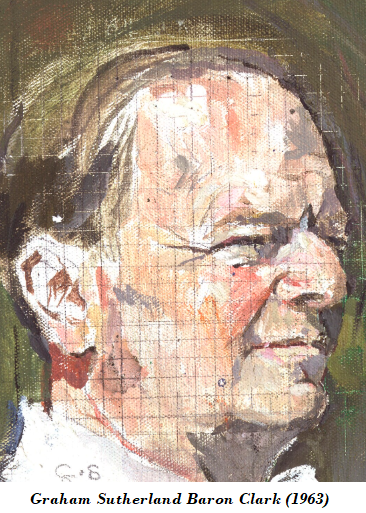
Nearly half a millennium separates Michelangelo’s Pieta (1499) from Andres Serrano’s Piss Christ (1987, below). Exquisitely carved from marble, Michelangelo’s masterpiece depicts Jesus Christ, recently crucified, lying dead in his mother’s lap. Serrano’s puerile provocation consists solely of a photograph of a plastic crucifix immersed in the artist’s urine in a glass container hanging on a wall.

The first expresses the Neoplatonic idea that the spirit can ascend out of matter into a higher realm; the second insists that only the material realm is real and that attempts to transcend it deserve contempt and ridicule. One represents the spiritualization of matter; the other the materialization of spirit. Both works epitomize the achievements of what are considered High Art in their respective eras: one, 500 years ago, in the High Renaissance; the other, ours, in the Age of Modernity. One is glorious; the other is grotesque. How did it come to this?

Breathtaking: Sir Kenneth Clark’s monumental survey, Civilisation, provides a context to help explain this incredible descent into barbarism. It is an awesome saga, stretching across 1500 years, seen from the perspective of art, literature, and music. It culminates around the turn of the 20th Century in a cultural cul-de- sac, a denouement that left Clark almost speechless, as we have seen.
Desecration: During his life-time, Clark witnessed the desecration of all the values he identified at the end of Episode 13, the values that underpinned the great civilisation he had spent his lifetime studying. This desecr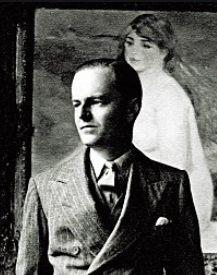 ation and Clark’s reaction to it shaped Civilisation and remains highly relevant today, as lovers of art struggle to comprehend how such banal travesties as Piss Christ can be considered ‘art’. In this Postscript we will pursue the direction of art up until the moment Clark presented Civilisation in 1968, seeking to illuminate this desecration and his reaction to it.
ation and Clark’s reaction to it shaped Civilisation and remains highly relevant today, as lovers of art struggle to comprehend how such banal travesties as Piss Christ can be considered ‘art’. In this Postscript we will pursue the direction of art up until the moment Clark presented Civilisation in 1968, seeking to illuminate this desecration and his reaction to it.
Questioning Modernism: It was in 1935 that Clark, then a rising young critic (right), first dared to question the aesthetic rationale of Modernism. This massively important cultural movement emerged at the end of the 19th Century and rose to dominance in the early decades of the 20th Century as the umbrella movement for a bewildering variety of styles: e.g., Cubism, Fauvism, Futurism, Vorticism (below), Expressionism, Dada, Surrealism, etc. In an article in The Listener on ‘The Future of Painting’, Clark argued that the complexities of Modernism made “the art of painting … impossible”.
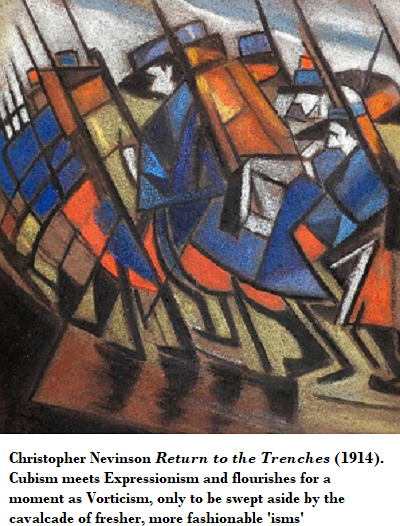
The Case for the Prosecution Echoing Ruskin’s formula: Nature : Beauty : Truth, Clark rejected the idea that fine art (as opposed to decoration) could be produced that had no representational or figurative qualities, i.e. that didn’t reference the concrete world in some way, but rather escaped into total abstraction. He also criticised the excessive theorising that had become necessary to explain and justify the new styles, given their lack of immediate aesthetic appeal. In addition, he questioned the insistence that these new styles were aesthetically very advanced and the wave of the future, and that it was up to the benighted viewing public to catch up with their sophistication. He also doubted that any lasting artistic achievement would emerge out of an art movement increasingly concerned to talk only to itself, constantly reassuring itself of its superiority over all that went before. And he expressed doubts that the Modernists really were, as they claimed, the aesthetic expression of a new society (e.g., Communism) that was in the process of being born.
Clark Gets ‘Cancelled’: Clark quickly became a target of what is now called the ‘cancel culture’ exercised so ruthlessly by the intelligentsia, the avant-garde, and the left generally. Outraged champions of Modernism leapt forth to denounce Clark as ‘behind the times’, as ‘pontificating’ about ‘sophisticated’ artistic styles that he allegedly knew nothing about, while one prominent critic declared Clark “wanted a well planted kick in the pants.” Clark knew he was in danger of being marginalized and complained that he was unfairly being portrayed as a reactionary ‘Colonel Blimp’ when he was the proud owner of many contemporary works of art and an enthusiastic patron and supporter of contemporary artists. These included the sculptures of Henry Moore, and the paintings of Graham Sutherland, all of which retained contact with the representational dimension of art.

The Emperor’s Clothes: Such protestations meant little to a nervous avant-garde that felt itself under mortal attack from a highly credible critic whose astute observations threatened to reveal that the emperors of Modernism were without clothes. They took particular exception to Clark’s observation that
good visual art is not an invariable accompaniment of civilised life, [that] there have been slack periods
and that Modernism may be one of these. The thought that they were not the highway into the future, but only a cultural cul-de sac or detour into decadence, sent the Modernists into a fury.

Juggernaut: Fortunately, cultural barbarism, decadence and destruction is something our civilisation has previously survived, as Clark would make clear 30 years later in Civilisation, a series that made it possible to place the decades of Modernism in an historical context that stretched across millennia. Episode by episode, Civilisation constructed a colossal statement about the power and richness of the Western cultural tradition. It was a juggernaut of achievement before which the pretensions of Modernism are revealed to be merely puny pretenders to any sort of significant position in that tradition.
Out of Darkness: It was by ‘The Skin of Our Teeth’ that the essential elements of civilisation endured, as Clark described in his first episode. Centuries passed in the gloom and stasis of the Dark Ages, as the scribes struggled to keep alive the vital remnants of the Classical past, illuminated by flickering candles in isolated monasteries while the forces of barbarism raged outside. What would these anonymous scriveners have thought about Piss Christ, one can’t help but wonder.
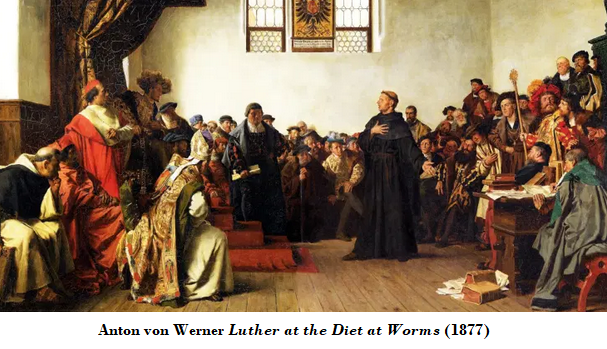
Into Light: The juggernaut began to move during ‘The Great Thaw’, which Clark evoked in his second episode. Civilisation then emerged into the light of history in the 12th Century, tracing its ascent through the ‘Romance and Reality’ of the Gothic era, and into the Age of Humanism and the Renaissance. For that brilliant era we explored ‘Man – the Measure of all Things’ and ‘The Hero as Artist’. These episodes were followed by ‘Protest and Communication’, which described the upheavals of the Printing Revolution and the Reformation. Clark then guided us through the extravagance of the Baroque period, characterised by ‘Grandeur and Obedience’, as the art of a lush and emotional Catholicism (below) confronted that of an austere and reserved Protestantism (above).
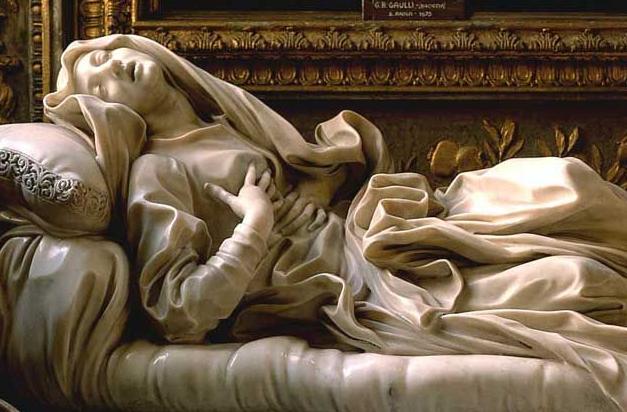
Science & Reason: After that, Civilisation took a sudden turn and we witnessed the stupendous discoveries of the Scientific Revolution and a new concern with the empirical world, guided by ‘The Light of Experience’. Clark then described the rise of mercantile capitalism and the everyday art that it promoted in ‘The Pursuit of Happiness’. Underpinning this was a new faith in the icy logic of science and rational analysis, exemplified by Descartes and Newton, and introduced into the world under the beguiling ‘Smile of Reason’. The juggernaut of civilisation now possessed an incredible, world-conquering momentum.

Romantic Reaction: We then explored the epoch-shaping Romantic Movement, and its rebellion against what it perceived as an over-rational but merely mundane, workaday-world, bereft of Mystery and Spirit. Faith in a transcendent God had receded and so people sought out and found a new divinity, closer at hand, in ‘The Worship of Nature’. Moreover, solitary (but hopefully inspired) individuals were made sovereign, and their exalted insights promised liberation from ‘mind-forged manacles’, while all conventions and limitations were denounced in the name of this quest. The infinite stretched out before us.
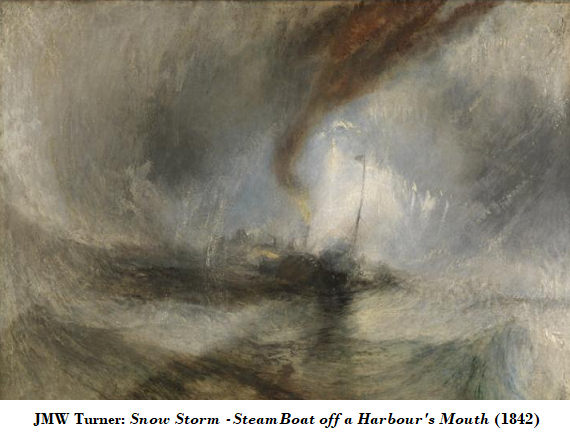
Denouncing the ‘Bourgeoisie’: This promethean quest for the Absolute collided with the brutal realities of human nature and politics in the French Revolution (below), Napoleon’s imperial onslaught, and their cataclysmic impact on Europe. Clark discussed this in ‘The Fallacies of Hope’, in whose shadow he felt we still lived in the aftermath of ‘Heroic Materialism’, the era that he addressed in his final episode. This is still our age in the West, the age of the masses, the bourgeoisie, and the middle-class, with whom self-proclaimed Modernist artists and writers wished to have no association, and against which they declared war.
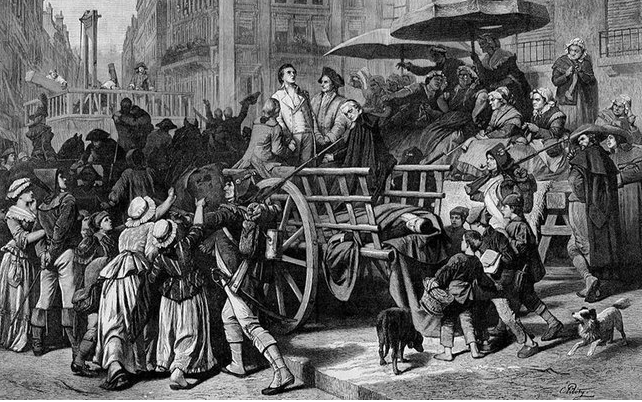
Contempt: The avant-garde made its animosity clear, early on. As Clark observed of Delacroix, he came to have
the utmost contempt for the age in which he lived … and his art is almost entirely an attempt to escape from it.
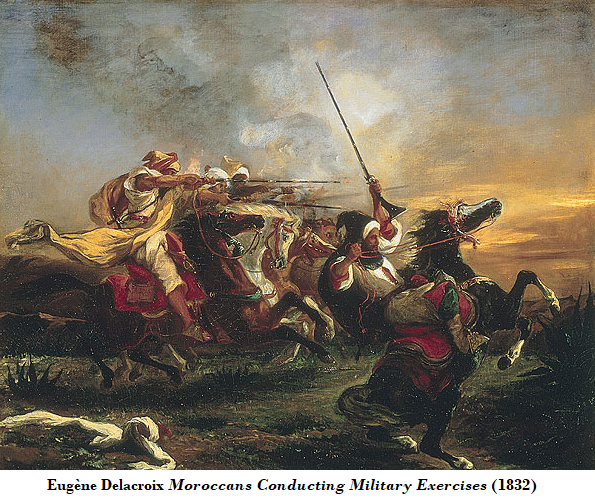
This pervasive distaste drove Delacroix to Morocco just as a later artist, Paul Gauguin, would escape to Tahiti:
his Byronic hatred of the society of his time had made him determined to escape from European civilisation, whatever the cost … What had gone so wrong with the European spirit that so long a journey and so great a renunciation were necessary?
Collapse: What indeed? What had brought the juggernaut of Western Civilisation to a shuddering halt? Clark insisted that the viability of civilization comes down to confidence, and that
it is lack of confidence – more than anything else – that kills a civilisation.
And, sadly, confidence in the core values of Western Civilization came under increasing stress through the latter part of the 19th Century, and collapsed completely in the 20th Century, with the triumph of Modernism.
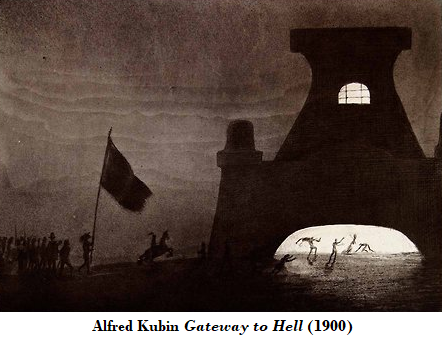
Decadence: This collapse was heralded by the Decadent Movement, a name that refers to the influential theory that all civilizations are undermined from within by decadence and degeneration. The Decadents pursued these dark themes, e.g., G. A. Sartorio, Diana of Ephesus and the Slaves (1899) and nurtured a profound pessimism, e.g., Alfred Kubin, Gateway to Hell and Franz Kupka, The Black Idol (1903, below).
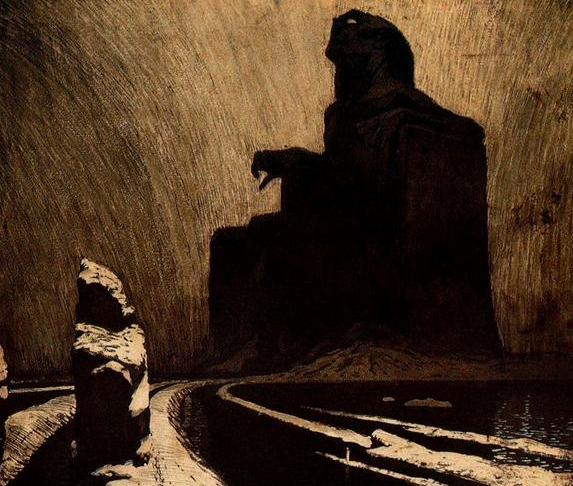
The Abyss of History: This bleak cultural despair, with its roots in the 19th Century, became acute after the Great War, a conflagration that impoverished an entire continent; destroyed four great imperial powers, engulfed some 70 million combatants and left over 9 million dead, along with 7 million civilians. Above all, it utterly discredited the faith in progress that had energised Europe through the previous century and opened the door for the ‘politics of cultural despair’ that had lurked underground for decades. As the French poet, Paul Valery observed at the time:
Modern civilization has learned that we are mortal like the others of the past … Now we see that the abyss of history is deep enough to bury the entire world. We feel that civilization is as fragile as a life.
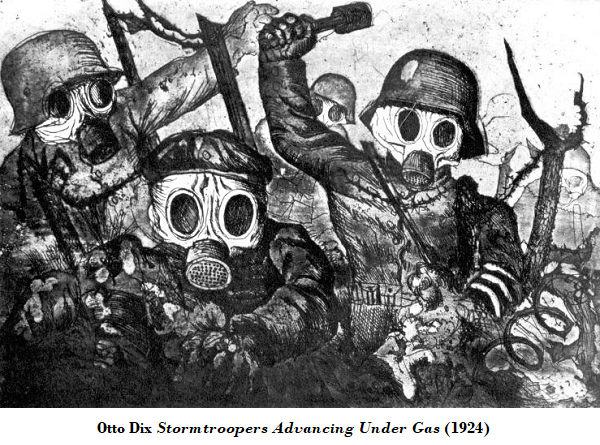 The Decline of the West: This pervasive pessimism was embraced by various historians. Oswald Spengler, in The Decline of the West (1918-22) argued that civilizations are organic life-forms that pass through a predictable cycle of birth, youth, maturity, decline, and ultimately death. Beginning as creative, spontaneous, and energetic, they slowly lose their élan and decline into a bureaucratic and enervated old age, at which point they thrash about blindly as they try desperately to survive. Western Civilization has entered into this final decline: the Great War and the chaos surrounding it were the beginning of its death-throes as it inevitably sank into decadence and decay. The Decline of the West had a massive impact: as the German philosopher, Ernst Cassirer, observed:
The Decline of the West: This pervasive pessimism was embraced by various historians. Oswald Spengler, in The Decline of the West (1918-22) argued that civilizations are organic life-forms that pass through a predictable cycle of birth, youth, maturity, decline, and ultimately death. Beginning as creative, spontaneous, and energetic, they slowly lose their élan and decline into a bureaucratic and enervated old age, at which point they thrash about blindly as they try desperately to survive. Western Civilization has entered into this final decline: the Great War and the chaos surrounding it were the beginning of its death-throes as it inevitably sank into decadence and decay. The Decline of the West had a massive impact: as the German philosopher, Ernst Cassirer, observed:
Most of us realized that something was rotten in our beloved Western Civilization. Spengler’s book expressed in a sharp and trenchant way this general uneasiness.
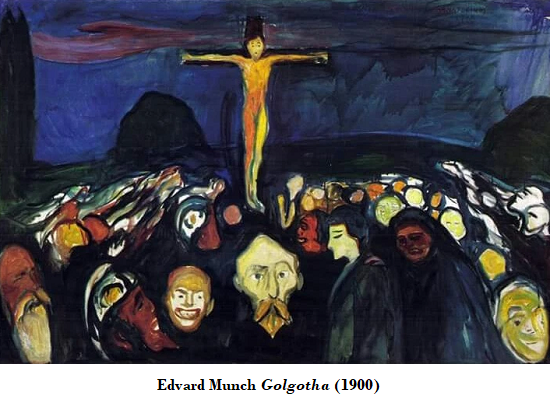
The Rising Tide: In America, the influential historian Lothrop Stoddard (left) published The Rising Tide of Color (1920) and The Revolt Against Civilization (1922). Writing a century ago with striking prescience, he predicted the internal decay of the West as an unemployable underclass grew in power; the collapse of the European empires in the face of 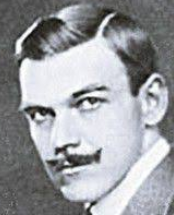 Third World nationalism; the industrialization of Japan, China, and India; the rise of Japan as a world power prepared to go war with America, along with a second war in Europe; a Third World population explosion and mass uncontrolled migration into the West; and the rise of Islam as a major threat to Western Civilization.
Third World nationalism; the industrialization of Japan, China, and India; the rise of Japan as a world power prepared to go war with America, along with a second war in Europe; a Third World population explosion and mass uncontrolled migration into the West; and the rise of Islam as a major threat to Western Civilization.
The Souls of Black Folk: The great African-American historian and sociologist, W.E.B. Du Bois, had a similarly race-based theory of history, and wrote innumerable books, 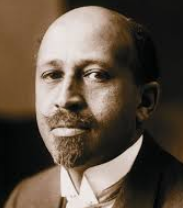 including The Souls of Black Folk (1903) and Africa: Its Place in Modern History (1930). Du Bois (right) looked forward to the collapse of a ‘degenerate’ Western Civilisation and the rightful ascendency of the world’s ‘people of colour,’ who, he insisted, alone possessed the essential ‘life-soul’ and were ‘the natural aristocracy, the makers of art, religion, philosophy, life, everything,’ as he put it in Dark Princess (1928).
including The Souls of Black Folk (1903) and Africa: Its Place in Modern History (1930). Du Bois (right) looked forward to the collapse of a ‘degenerate’ Western Civilisation and the rightful ascendency of the world’s ‘people of colour,’ who, he insisted, alone possessed the essential ‘life-soul’ and were ‘the natural aristocracy, the makers of art, religion, philosophy, life, everything,’ as he put it in Dark Princess (1928).
Out of Africa: This fascination with Africa was quite intense amongst the avant-garde, impacting greatly on Henri Matisse and Pablo Picasso. African artworks, especially tribal masks were eagerly sought out and inspired Picasso’s proto-cubist ‘Black Period’ prior to the war.
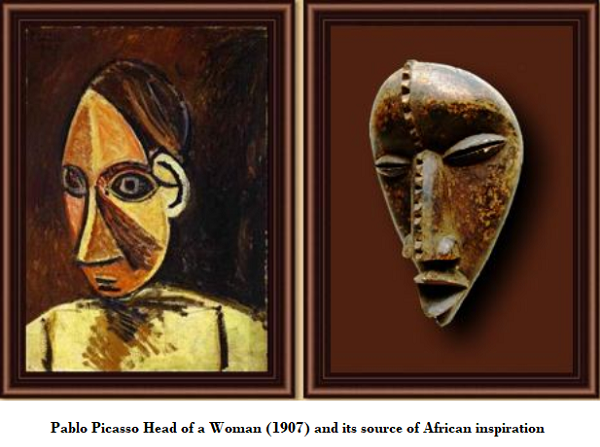 This is famously seen in one of his most controversial works, Les Demoiselles d’Avignon (1907, below) where he painted over the faces of the two figures on the right and replaced them with African masks.
This is famously seen in one of his most controversial works, Les Demoiselles d’Avignon (1907, below) where he painted over the faces of the two figures on the right and replaced them with African masks.
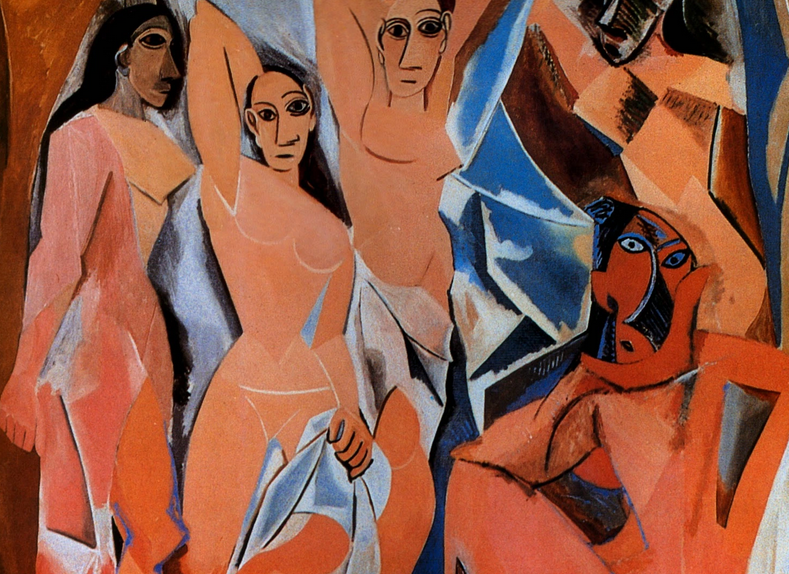
The Decay and Restoration of Civilization: In 1923 Albert Schweitzer published The Decay and Restoration of Civilization, warning that
we are living today under the sign of the collapse of civilization … it is clear that the suicide of civilization is in progress.
Public lectures were mounted in Britain, addressing topics such as these: ‘Can Civilization Be Saved?’, ‘The Tragedy of Human Existence’, and ‘Is Civilization Decaying?’ H.G. Wells, who had long anticipated the apocalypse in The War of the Worlds and The War in the Air, published a plan for The Salvaging of Civilization (1921), followed by The Shape of Things to Come (1933; film version 1936). This depicted an horrendous, war-wracked future for Europe that would take centuries to overcome.
 Death Wish: Such utterly bleak prognostications found vivid and influential expression in Sigmund Freud’s Civilisation and its Discontents (1930). Traumatised by the carnage of the Great War and its chaotic aftermath, Freud postulated the existence of Thanatos, a death drive towards non-being that balanced Eros, the drive for life, and that engulfed entire societies.
Death Wish: Such utterly bleak prognostications found vivid and influential expression in Sigmund Freud’s Civilisation and its Discontents (1930). Traumatised by the carnage of the Great War and its chaotic aftermath, Freud postulated the existence of Thanatos, a death drive towards non-being that balanced Eros, the drive for life, and that engulfed entire societies.
Challenge & Response The fragility of civilizations was also comprehensively analysed by Arnold Toynbee in his gigantic (12 volume, 3 million words) Study of History (1934>). He saw the rise and fall of civilizations in terms of a cycle of ‘challenge and response’. Civilisations rise as their energetic and creative elites respond constructively to massive challenges; they decline as these elites fail to respond adequately. When this failure occurs – as it inevitably must, according to Toynbee – civilizations enter into a process of breakdown and disintegration, characterized by a range of cultural pathologies, such as were vividly apparent at the time.

‘A botched civilization’: Crucially, the response of the Western Intelligentsia and the artistic avant-garde to the trauma of the Great War approximated Toynbee’s model. Faced with a colossal civilizational challenge, the intellectual and artistic elite chose not to double-down on preserving Western Civilization. Instead, they turned their back on it and celebrated its decline. As the Imagist poet (and later Fascist), Ezra Pound concluded, the West was
an old bitch gone in the teeth … a botched civilization.
Adversary Culture: Civilisation had nothing they wanted to champion (they told themselves) and so they presented themselves as rebels against it. Furiously, they embraced extreme ideological alternatives, notably Communism, but also Fascism and Nazism, all of which proclaimed and welcomed the destruction of a hated middle-class, bourgeois world. This posture found its home in Modernism, which made this adversarial stance its central defining characteristic, and this attitude has shaped Western art and culture ever since.

The Schlock of the New: Modernism was not a continuation of civilisation but a revolt against it, mounted via a bewildering cavalcade of disparate styles. As we’ve seen, Clark made this point by citing W. B. Yeats’ lament, The Second Coming (1920):
Things fall apart; the centre cannot hold;
Mere anarchy is loosed upon the world,
The blood-dimmed tide is loosed, and everywhere
The ceremony of innocence is drowned;
The best lack all conviction, while the worst
Are full of passionate intensity.
After 1500 years, the trajectory of art and literature in the West had culminated in a pervasive cultural disintegration that had left intact no central core of values, no strong point of orientation, and no firm foundations for art or civilisation.
Subjectivism: The dissolution of core cultural values opened wide the door to subjectivism and relativism. Firstly, Modernism embraced the idea that the true creative impulse springs from a source deep within the subject, at a primal, sub-rational level of emotional life, untouched by intellectual knowledge or academic training. Consequently, the purpose of art is to provide an outlet for the expression of the artist’s subjective emotional and int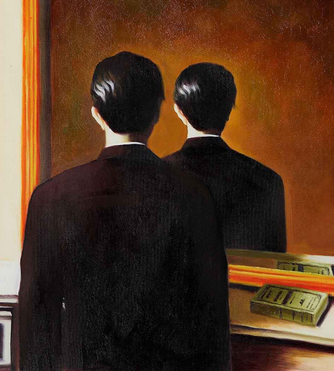 ellectual life. Indeed, Modernism was fixated on the ‘authenticity’ and ‘uniqueness’ of the artist’s vision, as if these contingent and elusive qualities provided a foundation for aesthetics or were some proof of ‘truth’. The self was intensely self-conscious and narcissistic, as Egon Schiele demonstrated with his innumerable ‘selfies’, but also mysterious and impenetrable, as with Rene Magritte’s Not to be Reproduced (1937, right).
ellectual life. Indeed, Modernism was fixated on the ‘authenticity’ and ‘uniqueness’ of the artist’s vision, as if these contingent and elusive qualities provided a foundation for aesthetics or were some proof of ‘truth’. The self was intensely self-conscious and narcissistic, as Egon Schiele demonstrated with his innumerable ‘selfies’, but also mysterious and impenetrable, as with Rene Magritte’s Not to be Reproduced (1937, right).
Relativism: Secondly, Modernism was also dismissive of all claims that there are any absolute or universal aesthetic values. And it had a dismissive view of the art of the past, and was obsessed with the new and the novel, which were seen as inherently valuable, irrespective of their objective worth. It presented itself as ‘outsider art’, battling against the artistic establishment and bourgeois conventionality. Modernism also placed a progressively lower premium on traditional artistic techniques, e.g., the ability to draw, use paint, and compose an image.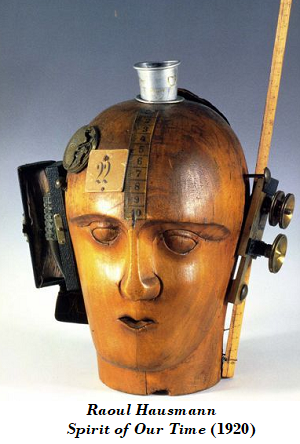
Dadaism: Nothing better exemplifies this disintegration of traditional aesthetic and cultural values than Dada, the extreme left-wing of Modernism. This explicit ‘anti-art movement’ began in Zurich in 1916 amidst the maelstrom of the Great War. Dadaism represented the dissolution of the European avant-garde in a nihilistic program of absolute rejection: of all logic, all reason, all traditions, and all aesthetic values. As one of its leaders, Tristan Tzara, declared, ‘All pictorial art is useless.’ Instead, Dada turned to the pursuit of random affects, nonsense, irrationalism and directionless protest in poetry, music, collage, painting, prints, costumes, and automatic writing. Dada promoted, said Tzara
the anti-man, the idiotic. Dada is using all its strength to establish the idiotic everywhere
Art could be created by simply exhibiting a urinal, as Marcel Duchamp demonstrated with his notorious Fountain (1917), nothing more than a ceramic urinal.
Inner Desolation: Dada expressed the disorientation and isolation that was the primal experience of innumerable artists and poets in the post-war years. As the Czech Expressionist poet, Franz Werfel, lamented in Out of My Depths:
From my depths I cried out to you [amid] engulfing fevers: Where am I? … I recognized the world. It was hanging by one last twitching nerve. I saw the deathly sweat on things as they thrashed about in spasms of agony.
The Scream: This Expressionist mentality had announced its arrival with Edvard Munch’s The Scream, an iconic image of which the artist obsessively produced five versions (below) between 1893 and 1910. This expressed the dread engulfing the Modernist self as it suddenly becomes aware that it is trapped alone in a threatening and uncertain world. It condensed into a single, emphatic statement the full weight of Expressionist angst.

Extremes: But Expressionism found its most extreme manifestation in post-war Germany, the seed-bed of Nazism. There, amidst the chaos of the Weimar Republic, Otto Dix documented the macabre effects of the war in Skat Players (1920), while Max Beckmann recorded Weimar Germany’s slide into decadence in The Night (1919), as did George Grosz in The Funeral (1918). There was also widespread paranoia, manipulated by politicians for their own purposes (and directed especially against the Jews). This was fed especially by German Expressionist cinema, which used state-of-the-art techniques in films like The Cabinet of Dr Caligari (1920), Dr. Mabuse: the Gambler (1922), and Nosferatu (1922) to create a nightmare world where nothing is as it seems, and arbitrary, mysterious, and malevolent forces prey on society and innocent individuals. In Metropolis (1927) the masses are depicted as beaten-down drones slaving away to support a corrupt and effete elite.
https://www.youtube.com/watch?v=_NSY6UGp3l8
The Kafkaesque: Another example of this paranoiac mood is Franz Kafka’s bleak novel, The Trial (1925), which tells the story of ‘K’ a bank officer who is suddenly arrested for no apparent reason; prosecuted by some unknown, remote and inaccessible bureaucratic authority; and ultimately executed ‘like a dog’, with the nature of his crime never revealed either to ‘K’ or the reader. The term ‘Kafkaesque’ came to describe the hellish world of all-powerful, labyrinthine, unaccountable bureaucracies that were taken to characterize modern civilization.
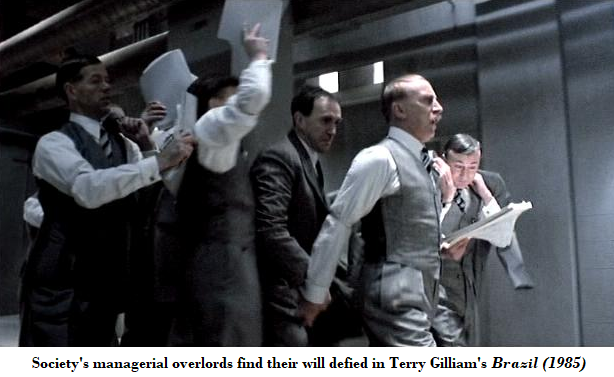
Surrealism: Paranoia was central to the next great Modernist movement. Surrealism evolved out of Dadaesque nihilism in the 1920s, but achieved a much higher level of theoretical justification and retained links to the figurative tradition. It encompassed painting, poetry, sculpture, and film. It focused intently on the liberation of irrational and unconscious instinctual forces, especially those revealed in dreams, and it saw these as a vehicle for revolutionary social transformation. The aim of this was a Dionysian libertarianism driven by the unleashed energies of the Libido and Id, and this became an explicit political objective, as we will see in a moment.
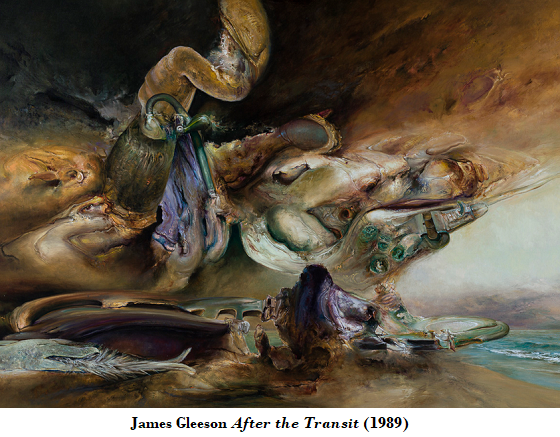 James Gleeson: Australia produced a brilliant surrealist artist and art theorist in James Gleeson, who explored dreams and the collective unconscious. ‘One of his most powerful themes was the disintegration of the human face and identity,’ as in We Inhabit the Corrosive Littoral of Habit (1940, below), where the self unravels; and The Citadel (1945), where it rots. (Christopher Allen, Art in Australia, 1997, p.139)
James Gleeson: Australia produced a brilliant surrealist artist and art theorist in James Gleeson, who explored dreams and the collective unconscious. ‘One of his most powerful themes was the disintegration of the human face and identity,’ as in We Inhabit the Corrosive Littoral of Habit (1940, below), where the self unravels; and The Citadel (1945), where it rots. (Christopher Allen, Art in Australia, 1997, p.139)
 Paranoid State: Surrealism derived its theoretical base from psychoanalysis and Marxism. And this was developed into the ‘Paranoiac-Critical Method’ by Salvador Dalí (right). According to this approach, the artist needed
Paranoid State: Surrealism derived its theoretical base from psychoanalysis and Marxism. And this was developed into the ‘Paranoiac-Critical Method’ by Salvador Dalí (right). According to this approach, the artist needed 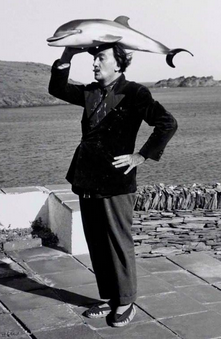 deliberately to invoke a paranoid state focused on the realization that the self is being targeted, manipulated, and controlled by a vast network of external forces, especially those of bourgeois capitalism. The aim was the deconstruction of personal identity so that the unconscious can be given full reign in the creation of art. The outcome of this method was represented in Premonition of Civil War (1936, below left). Its ultimate objective was a psycho-social and political revolution aimed at the overthrow of civilization.
deliberately to invoke a paranoid state focused on the realization that the self is being targeted, manipulated, and controlled by a vast network of external forces, especially those of bourgeois capitalism. The aim was the deconstruction of personal identity so that the unconscious can be given full reign in the creation of art. The outcome of this method was represented in Premonition of Civil War (1936, below left). Its ultimate objective was a psycho-social and political revolution aimed at the overthrow of civilization.
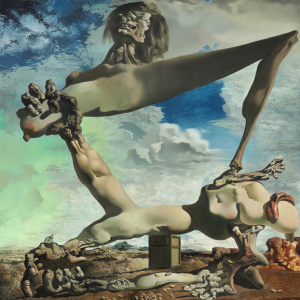 Agitators of the Mind: The revolutionary current within Surrealism found its chief theorist in Louis Aragon, a long-time member of the French Communist Party and a leading activist in the Communist International (Comintern). Writing in 1925 in La Révolution Surréaliste, he vividly described the radical nature and aims of Surrealism:
Agitators of the Mind: The revolutionary current within Surrealism found its chief theorist in Louis Aragon, a long-time member of the French Communist Party and a leading activist in the Communist International (Comintern). Writing in 1925 in La Révolution Surréaliste, he vividly described the radical nature and aims of Surrealism:
We will destroy this civilization that you cherish. Western world, you are condemned to death. We will awaken everywhere the germs of confusion and malaise. We are the agitators of the mind. We are those who will always hold out our hands to the enemy.
World Revolution: Aragon was reiterating the central policy of the Moscow-controlled Communist International, adopted at its Second Congress in 1920. This declared that the aim of the Comintern was to
struggle by all available means, including armed force, for the overthrow of the international bourgeoisie and the creation of an international Soviet republic as a transition stage to the complete abolition of the state.
All national communist parties (including Australia’s) were required to adopt and implement this policy in their respective countries. In particular, they were expected to radicalize and recruit writers, artists, film makers and intellectuals generally.
Liberal Paralysis: The context for the emergence of this adversary culture of the extreme left was the rise of Fascism in the inter-war years. Facing extremism on both the left and the right the centrist liberal democracies were paralysed by indecision and fear. Only the Comintern appeared to adopt a firm line against Fascism and the Intelligentsia and avant-garde flocked to its banner, with many artists becoming either party members, like Aragon and Pablo Picasso, or loyal fellow-travellers, like Dali.
Order Hal Colebatch’s
Australia’s Secret War: How Unions Sabotaged Our Troops in World War II
by clicking here
Consequently, the Nazi German–Soviet Union Nonaggression Pact of August 1939, which made Fascism and Communism allies in World War II against the liberal democracies, was a colossal, unimaginable, shock and propaganda nightmare that threw the Comintern and its national branch parties into a panic as they tried to identify their allegiances.
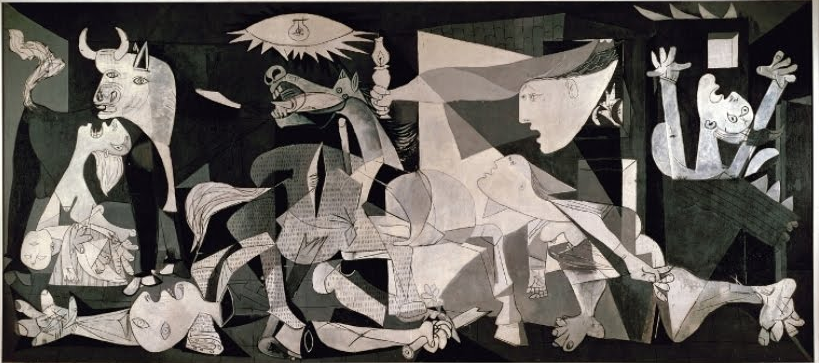
The Allure of Communism: Nevertheless, most of the avant-garde shared Pablo Picasso’s conviction that Communism
strives more than any other to know and to build the world, to make men clearer thinkers, more free and more happy.
They rejected a Western Civilization that they saw as decadent, philistine, bourgeois, exploitative, repressive, war-mongering, and imperialist, and embraced the view that it was Communism that ‘best defended the cultural values of our time.’
Guernica Nothing better exemplifies this propaganda victory than Picasso’s giant anti-war painting, Guernica (1937, above), the most iconic work of the 20th Century. Hurriedly produced, this protests the bombing of the Republican-held city of Guernica by the Nationalist-aligned and Nazi-backed Condor Legion during the Spanish Civil War. Guernica consolidated the belief amongst the Intelligentsia and avant-garde that only the Comintern and the Spanish Communist Party were prepared to fight for peace against war-mongering international fascism, while the liberal democracies sat on their hands. Picasso repeated this propaganda exercise with his pro-Communist Massacre in Korea (1951).
Politicization of Art: The Modernist idea that communism ‘best defended the cultural values of our time’ was doubly ironic. Firstly, the multiple betrayals committed by the Comintern and the monstrous purges carried out under Stalin made nonsense of the claim that Communism represented a future of freedom and humanity. Secondly, the Soviet Union turned its back completely on all versions of Modernism. It chose instead to adhere to Socialist Realism, a reactionary aesthetic indistinguishable from the Nazi aesthetic enforced by the Third Reich. Together, these styles became known as Totalitarian Art (below), and signalled the politicization of art that has characterised it ever since and has recently become intense.
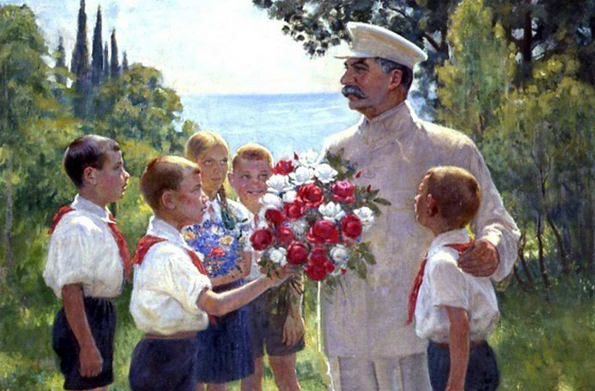
Socialist Realism: Socialist Realism was made the official style in the Soviet Union and Comintern. It was committed to producing idealized representations of communist life, but was little more than propaganda. Its explicit task was to proclaim the inevitable triumph of Communism; the always correct policies of the Party; and the glorious and heroic working lives of the industrial proletariat and the agricultural workforce, all of whom were considered to be its principle audiences. It was particularly concerned to promote the personality cult of the leaders, e.g., in fanciful pictures of Lenin and Stalin discussing state policy with groups of attentive peasants and workers.
Diktats for Modernists Such Socialist Realist diktats made life difficult for the Modernist avant-garde in the West. The most important of these was Picasso. As an abstract painter he was considered as ‘objectively’ a 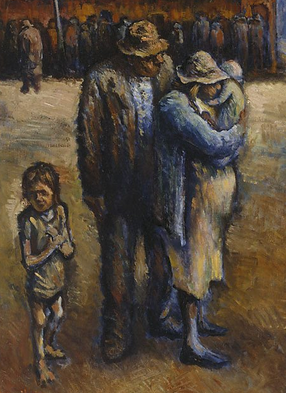 counter-revolutionary and had to be condemned. However, he was also a famous Communist Party member and a key ally in the propaganda war against the West. In the end, he was urged to undergo rigorous self-criticism and go to work alongside “ordinary people who want peace and so expose the warmongers, fascists, and monopolists.” Such advice was generally ignored by artists like Picasso who could afford to, and most Modernists just got used to living with the contradiction between their art and their politics.
counter-revolutionary and had to be condemned. However, he was also a famous Communist Party member and a key ally in the propaganda war against the West. In the end, he was urged to undergo rigorous self-criticism and go to work alongside “ordinary people who want peace and so expose the warmongers, fascists, and monopolists.” Such advice was generally ignored by artists like Picasso who could afford to, and most Modernists just got used to living with the contradiction between their art and their politics.
Noel Counihan: There were many obedient artists however, and one was Australia’s Noel Counihan. The Communist Party of Australia was a completely submissive member of the Comintern and its artist-members were expected to conform to the Socialist Realist style. Counihan loyally produced images of working-class struggle like At the Start of the March (1944, left), while following the then-current CPA party-line that Australian Modernism was ‘demoralizing and defeatist’.
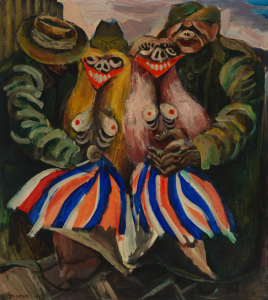 Victory Girls: Counihan may have been thinking of artists like Albert Tucker, whose Expressionst Victory Girls (1943, right) reduced the human form to little more than a lipstick grimace on skeletons caught up in a sordid sexual encounter with some Allied soldiers.
Victory Girls: Counihan may have been thinking of artists like Albert Tucker, whose Expressionst Victory Girls (1943, right) reduced the human form to little more than a lipstick grimace on skeletons caught up in a sordid sexual encounter with some Allied soldiers.
The Treason of the Intellectuals: In the face of this shift towards artistic and political extremism, only a few writers were prepared to defend Western Civilisation. The most prominent of these was Julien Benda, who published The Treason of the Intellectuals in 1927. Benda argued that the Intelligentsia and the avant-garde had lost its capacity to analyse and critique political ideologies in a rational and objective fashion; had embraced irrationalism; tended to worship power for its own sake; despised Western Civilization; and was blindly working for its destruction with little thought of the ultimate outcome. This remains the dominant paradigm of the avant-garde and Intelligentsia.
Conversion to Extremism: Their mass conversion to various forms of political and aesthetic extremism was a huge ideological victory for Communism and the left generally, with consequences that last to this day. Indeed, much of the artistic and intellectual history of the past century can only be understood in terms of the unchallenged hegemony of this adversary culture and its relentless criticism of the West. Clark began to realise this in 1935 and its fruits were obvious in 1968.
Anti-Civilisation: The 20th Century saw the emergence and consolidation within the West of something unprecedented: an ‘anti-civilisation’, i.e., an artistic, literary, and cultural movement that defined itself in terms of its opposition to – indeed, hatred of – the very civilisation that nurtured and sustained it. The implications of this have resonated profoundly throughout contemporary history, very nearly tearing Western Civilisation apart, as we will see in the second half of this ‘Postscript’ to Civilisation.
 Sign In
Sign In 0 Items (
0 Items ( Search
Search










Thank you, Mervyn Bendle, for your extended commentary on Lord Clark’s elegy. A close reading of your work has enhanced for me the television series & its subsequent book. But just as I needed your help in embracing the vastness of civilisation’s history, I’m still at a loss to understand how its decline, in the absolute terms implied here, can be said to be happening unchallenged. Given that high culture has always been the preserve of the few, surely more people than ever before value its merits? Vulgarity is abroad, it’s true, but the same mass media that ensures its spread also broadcasts to the likes of me on my few acres near a tiny country town the beauty and elegance of human accomplishment. “Since someone will always be surprising / A hunger in himself to be more serious”, as Larkin pointed out, surely hope abounds in the right quarters?
Thank you for your thoughtful comment.
Something truly disconcerting has happened to ‘Civilisation’ over the past dread-filled century, possibly comparable to the decline of Rome (as it has become a cliche to observe). Nevertheless, the human spirit does blossom forth, as you observe.
We try to end on a positive note, as we’ll see in the final part next week.
Thank you Merv, for this so informative and informed piece. The recent Biden win seems to me to be just another brick in the wall — or rather, brick out of the wall of our erstwhile marvellous civilisation. Do we just cultivate our own gardens or can we do something to help reclaim our rightful inheritance?
Thankyou Mervyn for your erudite article. What would you say about “Post-modernism”? The various labels that are in use across art, music, philosophy etc are a little confusing at times. Philosophers (eg Steven Hicks) would call the Modern period that scientific/rationalist era following the Enlightenment; and probably ‘Post-modern” as those thinkers against this in the second half of the 20C.
MB, thank you for being such a generous and insightful guide. Perhaps you might share with us the reason you decided to revisit the series at this time in the final part next week.
In Lord Clark’s last episode, Heroic Materialism, he said: “we have no idea where we are going” (39min.) Oh yes we do”, many – the West’s political class, environmental Romantics such as St Greta and the climate controllers – would claim today. “We are headed for a Zero Carbon (dioxide) utopia by 2050”.
For me, the last half century has seen the rise of a few malignant influences on Clark’s notion of “civilsation’: – “If civilsation is to survive, society must somehow be made to work” – e.g., what Jerome Ravetz called “post-normal’ science especially in the climate space, social media oligarchs and their Big Brother ambitions, ruthless machine politics, the fourth estate and the environmental impacts of contniuing human population growth. One could go on. While Clark was tough on Malthus, he admitted that “the terrible truth is the rise of population [in UK] did nearly ruin us.”
Clark concluded: “heroic materialism is not enough; one can be optimistic but not joyful,” What, I wonder, would be his conclusion today?
Thank you Stephen and Alice for your responses to my article. Clark devised and presented his series half a a century ago, which is why it seemed an appropriate time to explore his magisterial saga. Significantly, it has also been over the past 50 years that Modernism (as a cultural category) has been swept aside by Postmodernism, which we look at, in passing, next week. The Postmodern takeover of Western Civilisation is a major event that requires a seperate and comprehensive discussion; what Lord Clark would make of it is a good question, but one feels he would have found it very depressing. Overall, civilisations rise and fall over many centuries and it seems to be our fate to be witnessing possibly the final challenge facing ours (which doesn’t mean it has to succumb!)
“The renewal of civilization has nothing to do with movements which bear the character of experiences of the crowd; these are never anything but reactions to external happenings. But civilization can only revive when there shall come into being in a number of individuals a new tone of mind independent of the one prevalent among the crowd and in opposition to it, a tone of mind which will gradually win influence over the collective one, and in the end determine its character. It is only an ethical movement which can rescue us from the slough of barbarism, and the ethical comes into existence only in individuals.” The decay and the restoration of civilization
A. Schweitzer